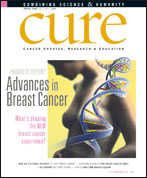Publication
Article
CURE
Screening for Recurrent Breast Cancer
Author(s):
The mainstays of screening for recurrent breast cancer remains physical exams and mammography, although researchers are looking for better ways to predict and find recurrences.
Despite the high-tech tool chest available to clinicians these days, routine followup screening of asymptomatic women for recurrent breast cancer still comes down to three familiar mainstays recommended by the American Society of Clinical Oncology: careful history taking, physical examination and regular mammography.
Updated guidelines from ASCO in late 2006 for breast cancer follow-up and management include breast exams every three to six months for the first three years, every six to 12 months in the fourth and fifth years, and annually thereafter for women who underwent mastectomies.
Patients who had breast-conserving surgery should get a mammogram one year after the initial mammogram and at least six months after completing radiation. Patients at high risk for familial breast cancer syndromes should be referred for genetic counseling.
"Beyond history, physical exam and mammogram, there is no test of any proven value in routine screening for the large majority of women with breast cancer,” says Stephen Edge, MD, chief of breast surgery at Roswell Park Cancer Institute in Buffalo, New York.
A number of new tools are available for predicting recurrent breast cancer or for monitoring possible progression of disease. In February, attention focused on the Food and Drug Administration’s approval of MammaPrint®, the first molecular genetic profiling test for estimating whether breast cancer will spread or recur. However, experts say clinicians are unlikely to use the gene-based test at this time in the United States based on the difficulty of processing samples. A piece of the tumor removed during surgery must be shipped to a lab in the Netherlands, making the one- to three-week process impractical for everyday clinical use.
Although it received FDA approval in 2004 for predicting breast cancer survival, a blood test called CellSearch™ gained an additional approval in December 2006 for monitoring metastatic breast cancer. CellSearch detects circulating tumor cells that have detached from a tumor and entered a patient’s bloodstream.
Detecting recurrence at an early stage in asymptomatic women is only half the battle; the other is pairing test results with specific therapies known to improve outcomes.
Dr. Edge says such tests pose a thorny challenge. Detecting recurrence at an early stage in asymptomatic women is only half the battle; the other is pairing test results with specific therapies known to improve outcomes. Detection alone, Dr. Edge says, may simply increase the length of time a woman knows she faces a recurrence without any effective treatment options. The development of better tests for recurrence and effective treatments that may actually cure women at the very earliest signs of recurrence is a high research priority.





